This article is one of a six-part series on stakeholder alignment throughout the product development lifecycle.
Aha! Roadmaps | Best practices for stakeholder alignment: Review customer feedback
This best practices article is part two of a series focused on driving stakeholder alignment. In the first article, we looked at how to establish a clear strategic planning process — working with executive leadership to set goals and identify the key initiatives needed to achieve them. The next step is reviewing customer feedback and gathering input from the team to identify the best ideas to support those initiatives.
Ideation is fundamental to building great products. It is how you uncover new ways to serve your customers, delighting them with functionality that solves real problems. This is why it is so important to keep customer feedback top of mind as you make planning decisions. The good news is that if you already use an ideas portal to capture customer requests, this part is easy. You can analyze your data using powerful reports and AI-powered exploration to discover what your customers really want.
But there are always more opportunities to enhance your product than time allows. That is why seeking input from different internal teams (such as marketing, sales, and support) is crucial. Not only does this establish a strong foundation for collaborative planning, but it also enables you to gather different perspectives on how to improve your product. This is where built-in whiteboards become invaluable — they make it super easy to discuss existing ideas, capture new ones, and align on the most pressing needs.
From there, you will want to conduct deeper research to validate whether your recommendations are right (or not) before going all in. Choose from a variety of customer research tools — such as polls and empathy sessions — to truly get to the heart of what your customers need. This will help you drive alignment as you explore ways to achieve your product strategy and promote the best ideas to your roadmap.
Click any of the following links to skip ahead:
Step 1: Analyze feedback themes
Make it a point to review customer feedback trends as part of your strategic planning process. Reflecting on what customers are telling you at a macro level is key to driving product innovation and guiding your roadmap. Analyze the feedback data in your ideas portal, choosing from a variety of example reports (or creating your own) to quickly spot feedback patterns.
Here are some potential approaches:
Build a list report to quickly sort by the most popular ideas.
Create a column chart to see which idea categories are trending.
Use a pivot table to view the most popular ideas based on recent votes.
If you have the Aha! Ideas Advanced plan, you can access even more sophisticated feedback analysis.
Use the AI-powered exploration tool to automatically identify themes across all ideas in your portal.
Integrate with Salesforce to link feedback to revenue potential.
Analyze feedback by segment or organization to understand what specific customer cohorts are asking for.
Summarize your learnings in a workspace note and use it to help you identify the best ways to enhance your product. You can even embed the reports you created in your note for quick reference.
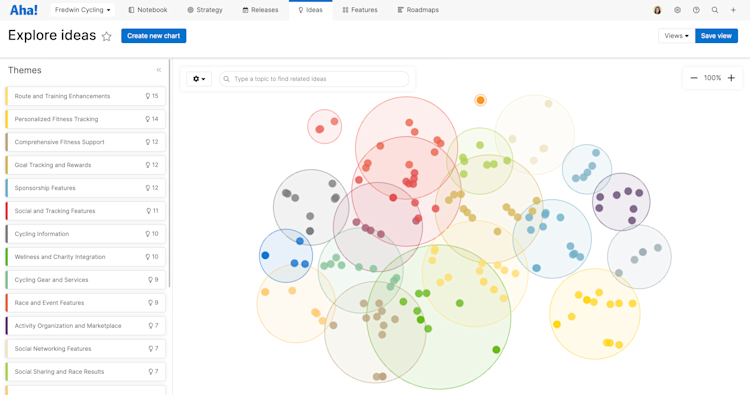
Step 2: Gather stakeholder input
Customers are important, but they are not your only stakeholders. Internal groups such as marketing, sales, and support also have valuable insights into the best ways to drive product growth. After reviewing customer feedback, share your learnings with the broader team and get different perspectives on which areas are worth addressing as part of your strategic initiatives.
Here is how to make collecting team input seamless:
Schedule a brainstorming session with key stakeholders. Share the agenda ahead of time — along with a note that maps out new insights — to help everyone understand what you are trying to accomplish. This will also help folks think through ideas on their own.
Set up a whiteboard with the Brainstorming session template. Add existing ideas directly to your whiteboard (either individually or in bulk) and group them by theme.
Invite people to add sticky notes to the whiteboard with their suggestions before or during your live session. Use collaboration tools such as emoji reactions and voting sessions (available on the Aha! Whiteboards Advanced plan) to get a clear sense of which ones the team thinks are the most impactful.
When your session is complete, record any new insights, organize everything into existing themes, and take note of any new themes that emerged. Later, you can determine how to align those themes with your product strategy.
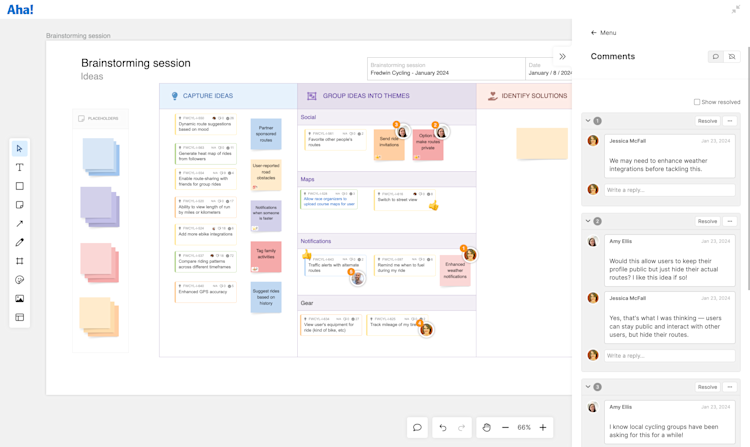
Step 3: Conduct deeper research
More insight means more direction. After gathering input from stakeholders, the next step is to perform additional research. You will want to validate your learnings by getting early feedback from customers on new product concepts. Use the Customer research plan note template from the Aha! template library to coordinate next steps. Then, reach out to your customers to get more context on their needs.
Choose customers to interview. It is a good idea to select people who have submitted ideas that align with your goals and initiatives. Your sales and support teams might also recommend customers for you to talk to.
Use the Customer interview note template to prepare your questions and record responses. After your customer interviews, use the Customer empathy map whiteboard template to map out their thoughts and concerns.
Add a poll to your ideas portal or to the in-app feedback widget to solicit even more insight.
If you are an Aha! Ideas Advanced subscriber, consider inviting portal users who voted on certain ideas to join an empathy session. Empathy sessions give you the opportunity to bring together customers with similar needs in a focused discussion — so you can gain a more holistic understanding surrounding their ideas and use cases.
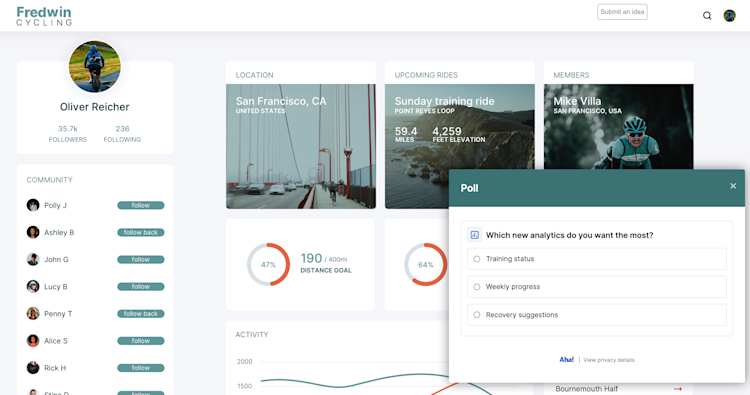
Step 4: Align your research with your initiatives
Now that you have researched deeply and discussed feedback with customers and stakeholders, it is time to revisit your product strategy to see which ideas are in alignment (or to consider adding new initiatives to reflect the insights you uncovered). Whiteboarding is a great way to lay out all the details and make these connections visually. Here is how:
Create a list report of your initiatives and export them to a whiteboard.
Add the feedback themes and top ideas you have identified to the same whiteboard. You can do this in bulk by exporting from a report or individually by pasting a record's URL into your whiteboard. You can also add some of your research notes to the whiteboard for reference.
Once you have your whiteboard set up, get to work:
Add a table to the whiteboard with your initiatives as the column headers.
Add your top ideas to the cells in each column. You can do this on your own or together with your team.
In the last row, add a sticky note to capture any additional context or details you want to include.
Share your whiteboard with other stakeholders to get their input. They can add inline comments or emoji reactions to your whiteboard — so you can quickly gauge their feelings about your plans.
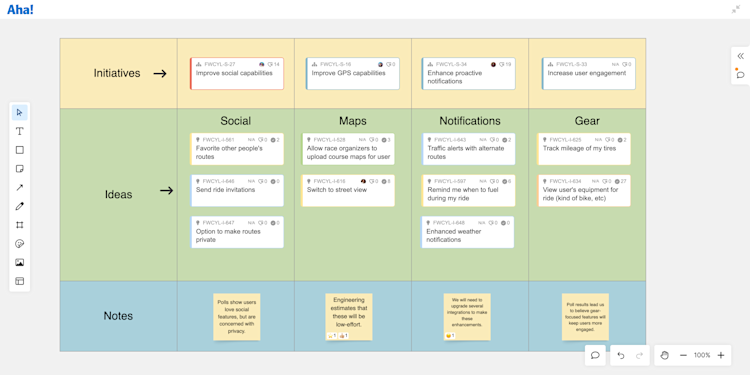
Step 5: Refine your strategic initiatives
You have gathered valuable feedback from customers. You have aligned that feedback with the strategic initiatives that you created in the first step of this series. And you have collaborated with stakeholders on the best path forward. Now, it is time to refine the definition and scope of each area of investment:
Keep your research and learnings easily accessible in workspace notes so your team can access them as needed. This information will come in handy when you prioritize work for implementation.
See where your initiatives need adjustment. You might need to update the description or scope of your initiatives based on what you have uncovered in your research.
Use the initiative prioritization page to rank your initiatives. You can add columns to your prioritization view for Total ideas linked to initiatives and Total votes on ideas linked to initiatives to help you gauge the popularity of ideas associated with each initiative.
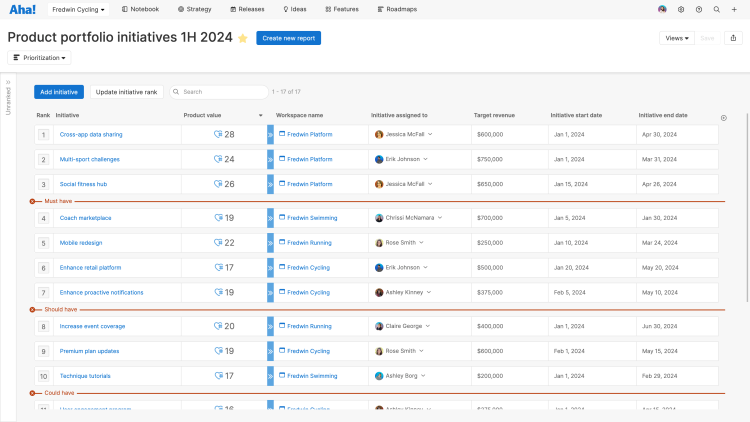
Now that you have alignment around which ideas to implement that support your product strategy, you can begin prioritizing ideas to build what will bring the most value to your business and customers.